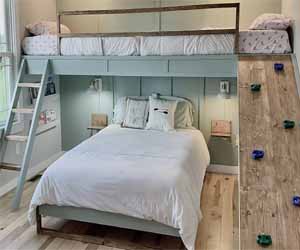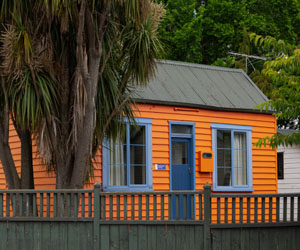


Making The Most Of Your Compact Living

In an era where many are embracing the concept of "less is more," small space planning has become a fundamental aspect of modern living. People are increasingly opting for smaller living spaces for various reasons, including a desire to simplify their lives, reduce their environmental footprint, and embrace a minimalist lifestyle. However, living in a compact space doesn't mean sacrificing comfort and convenience. With effective small space planning, you can transform even the tiniest of areas into organized and efficient sanctuaries.
The Benefits Of Small Space Living
Before delving into the intricacies of small space planning, it's essential to understand the advantages of choosing a compact living arrangement.
Simplicity: Small homes encourage a minimalist lifestyle, reducing clutter and allowing you to focus on what truly matters.
Eco-Friendly: Smaller homes typically have a smaller environmental impact, as they consume fewer resources for heating, cooling, and maintenance.
Cost-Effective: Compact spaces are generally more affordable, both in terms of initial purchase or rent and ongoing utility costs.
Less Maintenance: With less square footage, there's less space to clean and maintain, freeing up your time for other pursuits.
The Key To Small Space Success: Planning
Small space planning is an art, and it involves thoughtful consideration of every square inch. Here are some crucial factors to keep in mind when planning for your compact living space:
Multi-Functional Furniture: Invest in furniture that serves multiple purposes. For example, a sofa that doubles as a guest bed or a dining table with storage space can help maximize your limited square footage.
Vertical Storage: Make use of vertical space for storage. Wall-mounted shelves, hooks, and cabinets can help keep your belongings organized without encroaching on your floor space.
De-Clutter: Embrace the mantra of minimalism and declutter regularly. If you haven't used an item in the past year, consider whether you truly need it. Donating or selling items that no longer serve you is a great way to keep your small space tidy.
Light Colors: Lighter paint and decor colors can make a space feel larger and more open. Consider using a neutral palette to create the illusion of spaciousness.
Open Floor Plans: Knock down unnecessary walls or use open shelving to create a sense of flow and openness within your small space.
Use Mirrors: Mirrors can reflect light and make a room feel bigger. Strategically placing mirrors in your small space can create an illusion of depth and space.
Custom Solutions: If possible, consider custom-built storage solutions. Tailoring your storage to your specific needs can help you maximize every inch of your space.
Natural Light: Maximize natural light by choosing light-filtering window treatments. Natural light can make a small space feel brighter and more inviting.
Small space planning is an essential skill for those looking to embrace a minimalist lifestyle or those living in urban environments with limited square footage. By making thoughtful choices in furniture, decor, and organization, you can turn your small space into a comfortable and efficient sanctuary. Small living spaces are not about sacrifice; they're about creating a more intentional and fulfilling lifestyle while reducing your environmental footprint and saving money. So, if you're ready to declutter and simplify, start planning your small space today and unlock the potential of living with less.






The Pursuit Of Water Efficiency
 Sustainability: As populations grow and climate change exacerbates water scarcity, efficient water use is necessary to meet the needs of current and future generations.
Sustainability: As populations grow and climate change exacerbates water scarcity, efficient water use is necessary to meet the needs of current and future generations.
Environmental Preservation: Efficient water use helps protect aquatic ecosystems, conserves habitats, and reduces the negative impacts of water extraction on nature.
Economic Benefits: By reducing water waste, businesses and industries can cut costs, enhance their resilience to water scarcity, and maintain profitability.
Strategies For Achieving Water Efficiency
Numerous strategies and technologies promote water efficiency:
Water-Saving Appliances: Low-flow toilets, high-efficiency washing machines, and water-efficient faucets help reduce domestic water use.
A Sustainable Approach To Water Management
 The Importance Of Water Harvesting Systems
The Importance Of Water Harvesting Systems
Water harvesting, also known as rainwater harvesting, represents a forward-thinking approach to water management for several reasons:
Conservation: Water harvesting helps conserve precious freshwater resources by utilizing rainwater for non-potable purposes, reducing the demand on conventional water sources.
Environmental Stewardship: These systems promote responsible water use, reduce runoff, and contribute to the health of local ecosystems by preventing soil erosion and aiding in groundwater recharge.
Water Resilience: In the face of climate change and increased instances of drought, water harvesting can provide a dependable source of water for a variety of applications.
Cost Savings: By reducing reliance on treated water from utilities, water harvesting systems can lead to lower water bills and savings for both homeowners and businesses.
Types Of Water Harvesting Systems
Rooftop Rainwater Harvesting: This is one of the most common and straightforward systems. Rainwater collected on rooftops is channeled through gutters and downspouts into storage tanks or cisterns. It is often used for landscape irrigation, flushing toilets, and other non-potable applications.
Embracing The Future Of Convenience And Efficiency
 Smart Homes: The Cornerstone Of Automated Living
Smart Homes: The Cornerstone Of Automated Living
At the heart of automated living are smart homes. Smart homes are equipped with a wide range of devices and systems that can be controlled remotely and often autonomously. These include smart thermostats, lighting systems, security cameras, and even kitchen appliances. The integration of these devices into a centralized control hub, often accessible through a smartphone or voice-activated device, allows homeowners to create a fully automated and customized living environment.
Convenience Redefined
One of the primary appeals of automated living is the enhanced convenience it offers. Imagine arriving home on a scorching summer day to find your smart thermostat has already adjusted the temperature to your preferred level. Or, picture a scenario where your home's lights gradually brighten in the morning as you wake up, and your coffee maker starts brewing your morning cup without you lifting a finger. These examples illustrate how automation can simplify daily routines and make life more enjoyable.
Energy Efficiency
Automation also plays a pivotal role in promoting energy efficiency. Smart thermostats, for instance, can learn your heating and cooling preferences and create schedules that reduce energy consumption. Smart lighting systems can automatically turn off lights in unoccupied rooms, and smart appliances can operate during off-peak hours to save on energy costs.
Simplifying Life In The Modern World
 Defining Convenience Solutions
Defining Convenience Solutions
Convenience solutions are innovations that aim to eliminate or reduce the hassles and inconveniences we encounter in our everyday lives. They encompass a broad spectrum of offerings, from mobile apps and smart devices to delivery services and automation technologies. The overarching goal is to enhance our overall quality of life by minimizing the effort required to accomplish various tasks.
Home Automation
One of the most prominent categories within convenience solutions is home automation. Smart devices and systems are designed to control and manage various aspects of daily living. This includes intelligent thermostats that optimize heating and cooling, smart locks that enhance security, and voice-activated virtual assistants that can answer questions and perform tasks with simple commands. Home automation makes daily life more comfortable and efficient.
Illuminating Our Path To Sustainability
 Solar energy holds immense promise for the future for several compelling reasons:
Solar energy holds immense promise for the future for several compelling reasons:
Inexhaustible Resource: The sun, our ultimate energy source, is an almost inexhaustible and free resource. It continually emits an enormous amount of energy, more than humanity could ever consume.
Environmental Benefits: Solar power is one of the cleanest and most environmentally friendly energy sources available. It produces no greenhouse gas emissions, air pollution, or water usage, making it a key player in mitigating climate change.
Global Accessibility: Solar energy is accessible virtually everywhere on the planet. As long as there is sunlight, solar panels can be installed and harnessed, making it a democratic energy source.
Technological Advancements: Ongoing advancements in solar technology continue to drive down costs and improve efficiency, making it increasingly attractive and affordable for individuals, businesses, and governments.
The Role Of Solar Energy In The Future
Transition To Renewable Energy: Solar energy will play a pivotal role in the transition from fossil fuels to renewable energy sources. As our understanding of the urgency of addressing climate change grows, solar power will be an integral part of this shift.
Grid Integration: Future energy systems will be smart and interconnected, with solar power integrated into the grid to ensure a reliable and consistent energy supply.
A Fundamental Right And Social Imperative
 One of the critical challenges in addressing affordable housing is the ever-increasing demand. As more people move to urban centers in search of better economic opportunities, housing markets become strained. Limited supply and increasing demand often result in skyrocketing housing prices, pushing the cost of living beyond the means of many.
One of the critical challenges in addressing affordable housing is the ever-increasing demand. As more people move to urban centers in search of better economic opportunities, housing markets become strained. Limited supply and increasing demand often result in skyrocketing housing prices, pushing the cost of living beyond the means of many.
The consequences of unaffordable housing are far-reaching. Families are forced to live in overcrowded and substandard conditions, leading to health issues and reduced quality of life. Homelessness becomes a tragic reality for some, further exacerbating social problems. Moreover, the lack of affordable housing can perpetuate cycles of poverty, as families are left with limited resources for education, healthcare, and other essential services.
Affordable housing solutions are not only vital for individuals and families; they also have broader social and economic implications. Access to affordable housing can improve community stability, enhance economic mobility, and reduce the burden on social welfare programs. By ensuring that everyone has a place to call home, we create the foundation for stronger, more inclusive societies.
To address the affordable housing crisis, various approaches and strategies are being employed around the world. Government subsidies, tax incentives, and grants can stimulate the construction of affordable housing units. Public-private partnerships are another effective way to harness the resources and expertise of both sectors.
Creative Solutions For Limited Space
 1. Embrace Vertical Space
1. Embrace Vertical Space
One of the most effective ways to increase storage in a small home is by utilizing vertical space. Install tall bookshelves, wall-mounted cabinets, and floating shelves. These not only provide additional storage but also draw the eye upward, creating a sense of height and spaciousness.
2. Multifunctional Furniture
Invest in furniture that serves multiple purposes. Sofas with hidden storage, beds with built-in drawers, and coffee tables with lift-up tops are just a few examples of multifunctional pieces that can help you declutter your space. These items provide hidden compartments for your belongings, reducing the need for extra storage units.
3. Underutilized Spaces
In small homes, every nook and cranny counts. Look for underutilized spaces, such as the area under the stairs, beneath the bed, or inside closets. These spaces can be transformed into storage solutions like built-in shelves, pull-out drawers, or hanging racks.
4. Declutter Regularly
Living in a small home requires a commitment to decluttering regularly. Go through your belongings and be ruthless in your decision to keep, donate, or discard items that you no longer need or use. The less you have, the easier it is to organize and store what remains.